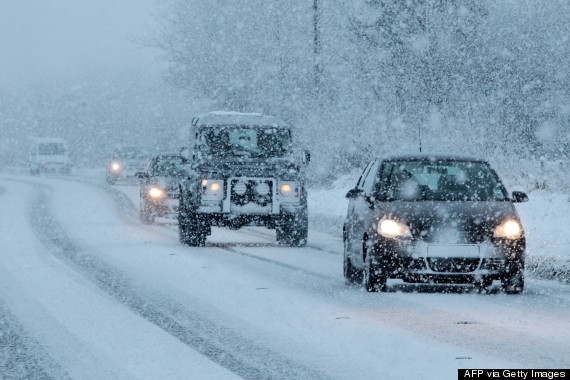Why Snow Guards Fail…
March 2nd, 2015
Imagine (or maybe you don’t have to imagine!) that you are an able-bodied adult male. If you were asked to keep a hold back a parked car from rolling down a gently sloped hill, you could probably do it, right?
Now imagine that you are in the direct path of a car coming down the same hill at 40 m.p.h. Would you be able to survive such an impact? Of course not.
Why should you expect a tiny snow guard to stop a heavy, moving ice and snow avalanche anymore than you could expect yourself to stop a fast moving car?
This scenario might seem a little comical, but in reality, it isn’t funny. Lives are lost each year due snow and ice avalanching off a roof and landing on someone below. Keeping the snow and ice on a roof isn’t accomplished by placing one or two rows of snow guards at the edge of the roof.
How do roof avalanches start?
Roof snow melts into water which then runs underneath the build up of snow on the surface of the roofing product. If there is enough water flow, the snow and ice release from the friction of the roofing product and an avalanche begins. If snow guards are placed throughout the roof area, protruding up three or more inches from the roofing product, then when the snow melts into ice, the field of snow and ice will freeze in place around the projections and prevent the ice from sliding off in a sheet. If the snow guards aren’t spaced close enough and spread throughout the roof, you will get an avalanche of heavy snow and ice.
Roof snow guards frequently fail because critical factors are not taken into consideration.
- The snow load. How much snow will fall on this roof? How much does it weigh? This data is available online and from the building department.
- The roof’s slope. A steeper roof will need more snow retention products.
- The type of roofing material. Each type has its own unique factors as to how the snow slips off. Each type will need a different type of snow guard.
- The method of fastening. Are nails, screws or adhesives used? Each type can pull out at varying rates. Plastic snow guards are generally attached with adhesive which must be attached to a clean surface under optimum temperatures.
- The sheathing type. This is important because fasteners pull out at varying rates based on the type and thickness. Many snow guards fail because fasteners and sheathing type/thickness are not considered.
Snow guards should be designed for the roof type (asphalt, metal, shake, tile) and should be attached securely and effectively for the sheathing type. The effectiveness of a snow retention system relies on each of these unique factors. Factoring in each item results in snow guards arranged throughout the roof area in an exact layout which, when working together as a system, prevent uneven loads and eventual avalanches.
Other reasons for snow guard failure
- Force loads are too high for the snow guard and its attachment system. When snow gets moving, it’s like a speeding car going downhill. A couple of snow guards haphazardly placed with little consideration to attachment pull-out rate or sheathing thickness or slope and snow load, just like one man, can’t stop it.
- Weight of the snow and ice in a given space. It’s important to place the snow guards all over the roof based on how much weight is expected. As snow melts and ice freezes around the part of the snow guard that sticks up from the roof (at least 3 inches is best), the whole field of snow/ice is anchored in place on the roof and less likely to slide off, but only if this layout is specifically engineered based on the specific factors.
In conclusion, the right layout and installation of snow guards work against the force of heavy snow. Too few snow guards will fail unless you have an engineered layout with the correct calculated number of snow guards than you can stop avalanching.
If you can’t remember all the details, just think about how hard it would be for one man to hold back a car and how it’s just as impossible for a couple of snow guards attached randomly to hold back an avalanche of snow. Then call us and we’ll do the calculating and engineering for you!

